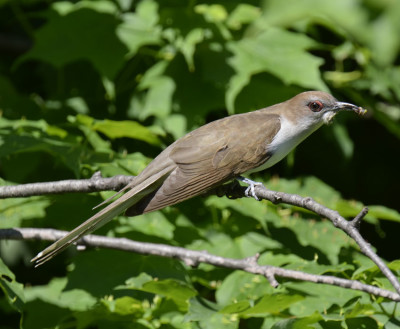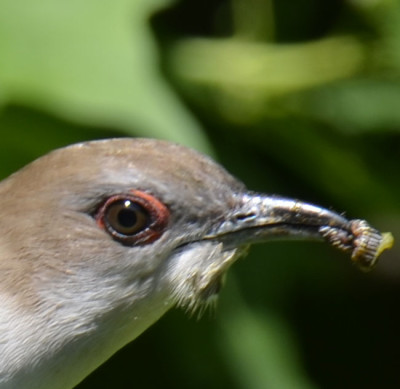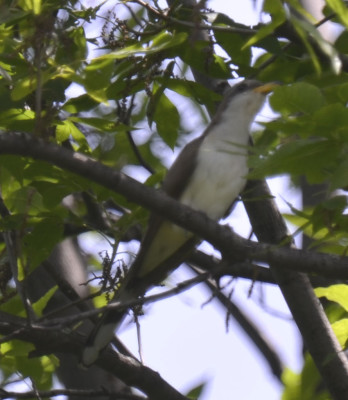Most people living in southern Ontario are familiar with the slightly sad sounding “hoo – hoo – hoo” of Mourning Doves. Personally, I think they sit up in the trees and on the roof tops at 5 a.m. and blow across the tops of opened bottles to make that hollow sounding “hoo.” But while walking through the forest at the Riverwood Conservancy this spring, several times I heard a different noise: a usually faint but occasionally quite loud “Coo coo coo.” Apparently some Cuckoos had broken free of their clock perches and landed in the tree canopy of the park, perhaps even to nest. Yes, Canadian cuckoos do build their own nests.
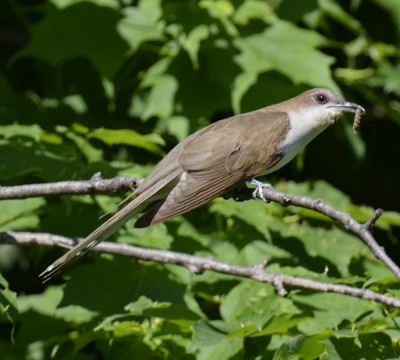
This Black-billed Cuckoo has caught one caterpillar but is watching for another.
Do Ontario Cuckoos Lay Their Eggs in Other Birds Nests?
The Common Cuckoo, or European Cuckoo, is well-known for laying its eggs in other birds’ nests and leaving them there for the other birds to raise. They don’t live in Canada, though.
Here in southern Ontario, there are two different species of Cuckoos: the Yellow-billed Cuckoo and the Black-billed Cuckoo.
Yellow-billed Cuckoos, according to the Cornell University website, build their own nests. Their nests are so important that the male frequently brings the female an extra bit to add to the nest during courtship and during brooding time. Their chicks hatch and fledge quickly so it would be easy to miss finding a nest before the birds are finished with it and have moved out into the canopy.
The website also says that occasionally Yellow-billeds will lay eggs in other birds’ nests. Oddly, it says they tend to do this when there is a very abundant food supply. I wonder if it is because the female Cuckoo is therefore able to produce more eggs than she can accommodate in her own nest, or if somehow she knows there is a better chance that her offspring will be well-fed even if fed by other birds?
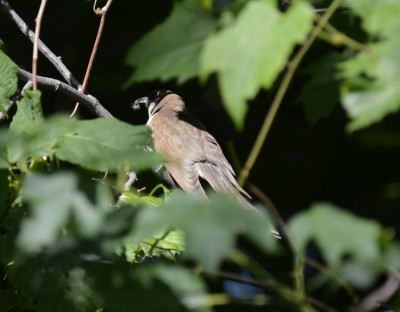
This would be considered by many as a good look at a Cuckoo: they hunt for caterpillars on the leaves of trees.
Black-billed Cuckoos, again according to the AllAboutBirds site, also build their own nests and the chicks hatch, fledge and leave the nest quickly. They also have been known to lay eggs in other birds’ nests. Their nests are much smaller and flimsier than those of the Yellow-billed Cuckoos which might be helpful to know for bird watchers in a park like Riverwood that is hosting both types of Cuckoos.
Are Cuckoos Shy or Show-offs?
Despite hearing the funny knocking call of the Yellow-billed Cuckoo and the simpler coo-ing call of the Black-billed Cuckoo on several visits to Riverwood, I never saw them.
Fortunately for me, Luc Fazio and Dan Salisbury led organized (free!) bird walks through the park in the spring. Not only did they point out exactly where one of each type of cuckoo was perched, but by some magic, they encouraged one down for a photo opp!
The Yellow-billed moved more quickly than I expected so I only managed shots of its back and tail but the Black-billed stayed long enough to allow amazing looks.
It was intent on eating a caterpillar it had just caught and ignored our small party and the click of the cameras.
Generally both types of birds are difficult to spot even though they are Robin-sized and very long tailed. They like to eat many things but especially larger caterpillars that live on the leaves of trees. Their hunting technique, according to AllAboutBirds, is to sit patiently until the movement of the caterpillar exposes it.
What Do Cuckoos Eat?
According to Cornell, both types of Cuckoos eat caterpillars, including many fuzzy and spiny caterpillars. They also eat cicadas and have been known to change locations to one with an outbreak of insects. They will also eat many other types of foods.
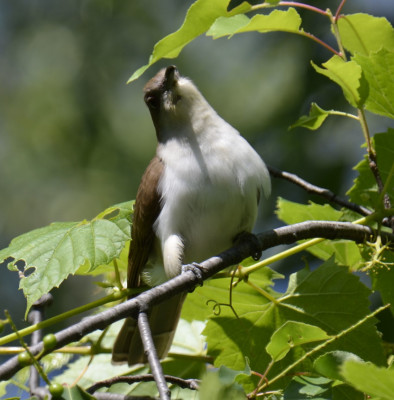
We got to watch this Black-billed Cuckoo’s hunting technique. It perched and tilted its head various directions then waited patiently to see if anything moved on the leaves and twigs overhead and nearby.
Do Cuckoos Like Tent Caterpillars?
Ontario has two common types of Tent Caterpillars. Most city-dwellers are more familiar with the Eastern Tent Caterpillar. It’s the one that builds the white silken tents in trees, especially favouring cherry and apple trees.
However, if you’ve ever lived in a forested area in Ontario, you may be familiar with the other Tent Caterpillar: the Forest Tent. In particular you likely have noticed that in certain years the population of Forest Tent Caterpillars explodes. Instead of noticing the occasional fuzzy creature climbing up a nearby tree trunk, you find them everywhere: on your deck chairs, in your flower garden, all over your car. These are the “Tent” caterpillars that do not build a tent.
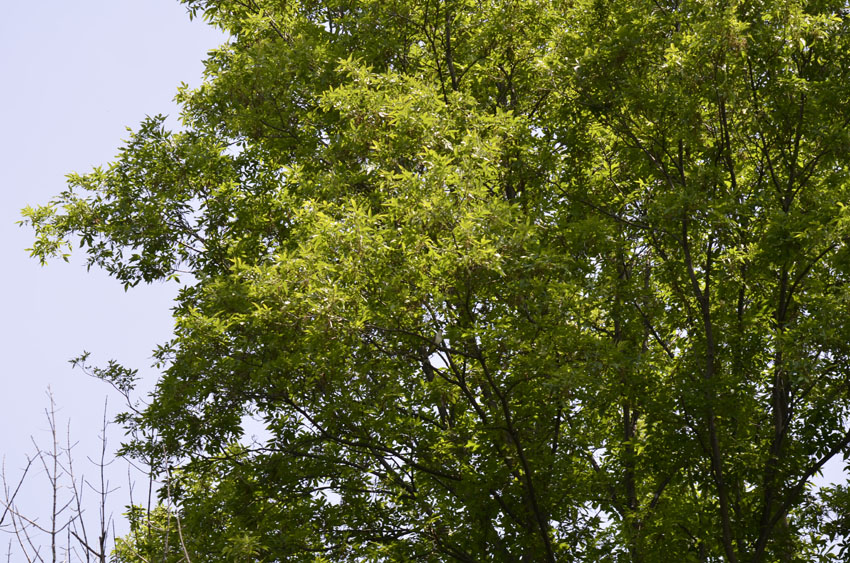
Without help, this was the best time I saw and photographed a Cuckoo at Riverwood. Can you spot it?
So I was curious whether Cuckoos appreciate these years of abundant Forest Tents. The Cornell website reports that both types do eat Tent Caterpillars. They even eat Gypsy moth caterpillars. Way to go, Cuckoos!
According to a CBC quote, Forest Tent caterpillar numbers peak about every 10 years and then drop significantly. This type of cyclical peak in caterpillar and cicada numbers may explain why Cuckoos are heard in one area for a year or two, then not heard for several, then heard again.
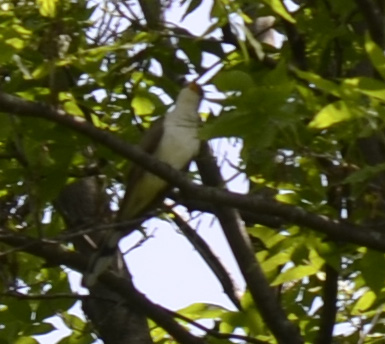
Yes, that’s the Yellow-billed Cuckoo in that little open patch of branches.
I’m certainly glad I got a chance to see both types of Cuckoos this year. It’s amazing how many interesting bird species visit the Greater Toronto Area, often without most people noticing.
Related Reading
- An Eastern Wood Pewee Calls Pee-a-Wee Pee-you from the Tree Tops
- What’s That Plain Grey Green Bird?
- What’s Mewing Like a Cat in the Lakeside Park Woods?
- Why Are All These Birds So Sadly Named?
Join In
Have you heard the cooing of Cuckoos, or any of the odd knocking and metallic sounds made by the Yellow-billed Cuckoos? Were you able to spot one of these shy birds? Please share your sighting with a comment.

